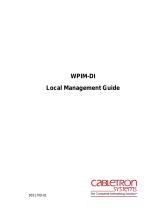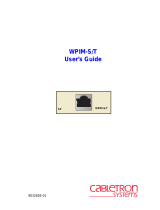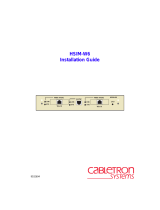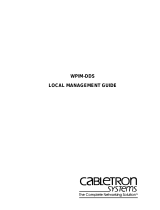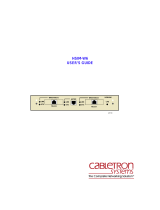Page is loading ...

WPIM
T1/DDS
T1
DDS
Title Page
WPIM-T1/DDS
User’s Guide
9032750


WPIM-T1/DDS User’s Guide i
NOTICE
Cabletron Systems reserves the right to make changes in specifications and other information
contained in this document without prior notice. The reader should in all cases consult Cabletron
Systems to determine whether any such changes have been made.
The hardware, firmware, or software described in this manual is subject to change without notice.
IN NO EVENT SHALL CABLETRON SYSTEMS BE LIABLE FOR ANY INCIDENTAL,
INDIRECT, SPECIAL, OR CONSEQUENTIAL DAMAGES WHATSOEVER (INCLUDING BUT
NOT LIMITED TO LOST PROFITS) ARISING OUT OF OR RELATED TO THIS MANUAL OR
THE INFORMATION CONTAINED IN IT, EVEN IF CABLETRON SYSTEMS HAS BEEN
ADVISED OF, KNOWN, OR SHOULD HAVE KNOWN, THE POSSIBILITY OF SUCH
DAMAGES.
1998 by Cabletron Systems, Inc., P.O. Box 5005, Rochester, NH 03866-5005
All Rights Reserved
Printed in the United States of America
Order Number: 9032750 December 1998
Cabletron Systems
,
SecureFast
,
QuickSET
,
and
LANVIEW
are registered trademarks, and
CyberSWITCH
is a trademark of Cabletron Systems, Inc.
All other product names mentioned in this manual may be trademarks or registered trademarks of
their respective companies.
FCC NOTICE
This device complies with Part 15 of the FCC rules. Operation is subject to the following two
conditions: (1) this device may not cause harmful interference, and (2) this device must accept any
interference received, including interference that may cause undesired operation.
NOTE:
This equipment has been tested and found to comply with the limits for a Class A digital
device, pursuant to Part 15 of the FCC rules. These limits are designed to provide reasonable
protection against harmful interference when the equipment is operated in a commercial environment.
This equipment uses, generates, and can radiate radio frequency energy and if not installed in
accordance with the operator’s manual, may cause harmful interference to radio communications.
Operation of this equipment in a residential area is likely to cause interference in which case the user
will be required to correct the interference at his own expense.
WARNING:
Changes or modifications made to this device which are not expressly approved by the
party responsible for compliance could void the user’s authority to operate the equipment.
Only qualified personnel should perform installation
procedures.

Notice
ii WPIM-T1/DDS User’s Guide
INDUSTRY CANADA NOTICE
This digital apparatus does not exceed the Class A limits for radio noise emissions from digital
apparatus set out in the Radio Interference Regulations of the Canadian Department of
Communications.
Le présent appareil numérique n’émet pas de bruits radioélectriques dépassant les limites applicables
aux appareils numériques de la class A prescrites dans le Règlement sur le brouillage radioélectrique
édicté par le ministère des Communications du Canada.
NOTICE:
The Industry Canada label identifies certified equipment. This certification means that the
equipment meets telecommunications network protective, operational and safety requirements as
prescribed in the appropriate Terminal Equipment Technical Requirements documents (s). The
department does not guarantee the equipment will operate to the user’s satisfaction.
Before installing this equipment, users should ensure that it is permissible to be connected to the
facilities of the local telecommunications company. The equipment must also be installed using an
acceptable method of connection. The customer should be aware that compliance with the above
conditions may not prevent degradation of service in some situations.
Repairs to certified equipment should be coordinated by a representative designated by the supplier.
Any repairs or alterations made by the user to this equipment, or equipment malfunctions, may give
the telecommunications company cause to request the user to disconnect the equipment.
Users should ensure for their own protection that the electrical ground connections of the power
utility, telephone lines and internal metallic water pipe system, if present, are connected together. This
precaution may be particularly important in rural areas.
Caution:
Users should not attempt to make
such connections themselves, but should contact the appropriate electric inspection authority, or
electrician, as appropriate.
NOTICE:
The Ringer Equivalence Number (REN) assigned to each terminal device provides an
indication of the maximum number of terminals allowed to be connected to a telephone interface. The
termination on an interface may consist of any combination of devices subject only to the requirement
that the sum of the ringer equivalence Numbers of all the devices does not exceed 5.
VCCI NOTICE
This is a Class A product based on the standard of the Voluntary Control Council for Interference by
Information Technology Equipment (VCCI). If this equipment is used in a domestic environment,
radio disturbance may arise. When such trouble occurs, the user may be required to take corrective
actions.

Notice
WPIM-T1/DDS User’s Guide iii
CABLETRON SYSTEMS, INC. PROGRAM LICENSE AGREEMENT
IMPORTANT:
Before utilizing this product, carefully read this License Agreement.
This document is an agreement between you, the end user, and Cabletron Systems, Inc. (“Cabletron”)
that sets forth your rights and obligations with respect to the Cabletron software program (the
“Program”) contained in this package. The Program may be contained in firmware, chips or other
media. BY UTILIZING THE ENCLOSED PRODUCT, YOU ARE AGREEING TO BECOME
BOUND BY THE TERMS OF THIS AGREEMENT, WHICH INCLUDES THE LICENSE AND
THE LIMITATION OF WARRANTY AND DISCLAIMER OF LIABILITY. IF YOU DO NOT
AGREE TO THE TERMS OF THIS AGREEMENT, PROMPTLY RETURN THE UNUSED
PRODUCT TO THE PLACE OF PURCHASE FOR A FULL REFUND.
CABLETRON SOFTWARE PROGRAM LICENSE
1. LICENSE
. You have the right to use only the one (1) copy of the Program provided in this
package subject to the terms and conditions of this License Agreement.
You may not copy, reproduce or transmit any part of the Program except as permitted by the
Copyright Act of the United States or as authorized in writing by Cabletron.
2. OTHER RESTRICTIONS. You may not reverse engineer, decompile, or disassemble the
Program.
3. APPLICABLE LAW. This License Agreement shall be interpreted and governed under the laws
and in the state and federal courts of New Hampshire. You accept the personal jurisdiction and
venue of the New Hampshire courts.
EXCLUSION OF WARRANTY AND DISCLAIMER OF LIABILITY
1. EXCLUSION OF
WARRANTY. Except as may be specifically provided by Cabletron in
writing, Cabletron makes no warranty, expressed or implied, concerning the Program (including
its documentation and media).
CABLETRON DISCLAIMS ALL WARRANTIES, OTHER THAN THOSE SUPPLIED TO
YOU BY CABLETRON IN WRITING, EITHER EXPRESSED OR IMPLIED, INCLUDING
BUT NOT LIMITED TO IMPLIED WARRANTIES OF MERCHANTABILITY AND
FITNESS FOR A PARTICULAR PURPOSE, WITH RESPECT TO THE PROGRAM, THE
ACCOMPANYING WRITTEN MATERIALS, AND ANY ACCOMPANYING HARDWARE.
2. NO LIABILITY FOR CONSEQUENTIAL DAMAGES. IN NO EVENT SHALL
CABLETRON OR ITS SUPPLIERS BE LIABLE FOR ANY DAMAGES WHATSOEVER
(INCLUDING, WITHOUT LIMITATION, DAMAGES FOR LOSS OF BUSINESS,
PROFITS, BUSINESS INTERRUPTION, LOSS OF BUSINESS INFORMATION, SPECIAL,
INCIDENTAL, CONSEQUENTIAL, OR RELIANCE DAMAGES, OR OTHER LOSS)
ARISING OUT OF THE USE OR INABILITY TO USE THIS CABLETRON PRODUCT,
EVEN IF CABLETRON HAS BEEN ADVISED OF THE POSSIBILITY OF SUCH
DAMAGES. BECAUSE SOME STATES DO NOT ALLOW THE EXCLUSION OR
LIMITATION OF LIABILITY FOR CONSEQUENTIAL OR INCIDENTAL DAMAGES, OR
ON THE DURATION OR LIMITATION OF IMPLIED WARRANTIES, IN SOME
INSTANCES THE ABOVE LIMITATIONS AND EXCLUSIONS MAY NOT APPLY TO
YOU.

Notice
iv WPIM-T1/DDS User’s Guide
UNITED STATES GOVERNMENT RESTRICTED RIGHTS
The enclosed product (a) was developed solely at private expense; (b) contains “restricted computer
software” submitted with restricted rights in accordance with Section 52227-19 (a) through (d) of the
Commercial Computer Software - Restricted Rights Clause and its successors, and (c) in all respects
is proprietary data belonging to Cabletron and/or its suppliers.
For Department of Defense units, the product is licensed with “Restricted Rights” as defined in the
DoD Supplement to the Federal Acquisition Regulations, Section 52.227-7013 (c) (1) (ii) and its
successors, and use, duplication, disclosure by the Government is subject to restrictions as set forth in
subparagraph (c) (1) (ii) of the Rights in Technical Data and Computer Software clause at
252.227-7013. Cabletron Systems, Inc., 35 Industrial Way, Rochester, New Hampshire 03867-0505.

Notice
WPIM-T1/DDS User’s Guide v
DECLARATION OF CONFORMITY
Application of Council Directive(s):
89/336/EEC
73/23/EEC
Manufacturer’s Name:
Cabletron Systems, Inc.
Manufacturer’s Address:
35 Industrial Way
PO Box 5005
Rochester, NH 03867
European Representative Name:
Mr. J. Solari
European Representative Address:
Cabletron Systems Limited
Nexus House, Newbury Business Park
London Road, Newbury
Berkshire RG13 2PZ, England
Conformance to Directive(s)/Product Standards:
EC Directive 89/336/EEC
EC Directive 73/23/EEC
EN 55022
EN 50082-1
EN 60950
Equipment Type/Environment:
Networking Equipment, for use in a
Commercial or Light
Industrial
Environment.
We the undersigned, hereby declare, under our sole responsibility, that the equipment packaged
with this notice conforms to the above directives.
Manufacturer Legal Representative in Europe
Mr. Ronald Fotino Mr. J. Solari
___________________________________ ___________________________________
Full Name Full Name
Principal Compliance Engineer Managing Director - E.M.E.A.
___________________________________ ___________________________________
Title Title
Rochester, NH, USA Newbury, Berkshire, England
___________________________________ ___________________________________
Location Location

Notice
vi WPIM-T1/DDS User’s Guide

WPIM-T1/DDS User’s Guide vii
CONTENTS
INTRODUCTION
......................................................................................ix
Using This Manual..........................................................................ix
Structure of This Guide...................................................................ix
Related Manuals..............................................................................x
Document Conventions..................................................................xi
Getting Help...................................................................................xii
CHAPTER 1 OVERVIEW
1.1 Firmware Revision.......................................................................1-2
1.2 WPIM-T1/DDS Features..............................................................1-2
1.3 WAN Protocols............................................................................1-3
1.4 MIB Support.................................................................................1-3
CHAPTER 2 SETUP AND INSTALLATION
2.1 Installing the WPIM-T1/DDS........................................................2-1
2.1.1 Unpacking the WPIM-T1/DDS........................................2-1
2.1.2 Pre-Installation................................................................2-2
2.1.3 Installing the WPIM-T1/DDS...........................................2-2
2.1.4 Post-Installation ..............................................................2-3
2.2 LEDs............................................................................................2-4
2.3 Required Operations ...................................................................2-4
2.3.1 Choosing T1 or DDS Mode.............................................2-4
2.3.2 WAN Configuration.........................................................2-5
2.4 Connecting the WAN cable to the WPIM-T1/DDS.......................2-6
CHAPTER 3 LOCAL MANAGEMENT FOR T1 SERVICE
3.1 The WAN Physical Configuration Screen....................................3-2
3.1.1 WAN Physical Configuration Screen Fields....................3-3
3.1.2 WPIM Line Configuration Fields .....................................3-4
3.1.3 The WPIM Timeslot Configuration Table........................3-5
3.2 The WAN Interface Configuration Screen...................................3-7
3.2.1 WAN Interface Configuration Screen Fields...................3-8
3.2.1.1 Frame Relay as the Protocol Manager...........3-8
3.2.1.2 PPP as the Protocol Manager........................3-9
3.2.1.3 Command and Interface Table Fields..........3-10

Contents
viii WPIM-T1/DDS User’s Guide
3.3 Full T-1 Configuration Using PPP..............................................3-11
3.3.1 T1 Service Physical Configuration ................................3-12
3.3.2 T1 Interface Configuration.............................................3-13
3.4 Fractional T-1 Configuration Using PPP....................................3-14
3.4.1 T1 Physical Configuration .............................................3-15
3.4.2 T1 Interface Configuration.............................................3-17
3.5 Frame Relay Configuration........................................................3-17
3.5.1 Frame Relay Physical Configuration.............................3-18
3.5.2 Frame Relay Interface Configuration ............................3-20
CHAPTER 4 LOCAL MANAGEMENT FOR DDS SERVICE
4.1 The WAN Physical Configuration Screen ....................................4-2
4.1.1 WAN Physical Configuration Screen Fields....................4-2
4.1.2 WPIM Line Configuration Fields......................................4-4
4.2 WAN Interface Configuration Screen...........................................4-5
4.2.1 WAN Interface Configuration Screen Fields....................4-5
4.2.1.1 Frame Relay as the Protocol Manager...........4-6
4.2.1.2 PPP as the Protocol Manager.........................4-7
4.2.1.3 Command and Interface Table Fields.............4-8
4.3 DDS Service Configuration..........................................................4-9
4.3.1 DDS Service Physical Configuration...............................4-9
4.3.2 DDS Service Interface Configuration ............................4-10
APPENDIX A SPECIFICATIONS
A.1 Physical Properties ..................................................................... A-1
A.2 Environmental Requirements...................................................... A-1
A.3 Regulatory Compliance............................................................... A-1
A.4 T1 Interface Cabling.................................................................... A-2
A.4.1 Cable Assemblies and Pinouts....................................... A-2
A.5 DDS Port Assignment................................................................. A-4
APPENDIX B FCC PART 68 - USER’S INFORMATION

WPIM-T1/DDS User’s Guide ix
INTRODUCTION
Welcome to the Cabletron Systems
WPIM-T1/DDS User’s Guide. This
manual provides hardware information and explains the use of Local
Management to control and manage the Cabletron Systems
WPIM-T1/DDS.
The WPIM-T1/DDS is installed in and provides connectivity and
functionality to the CSX400 and the HSIM-W6. The WPIM-T1/DDS
provides full or fractional T1, or a DDS interface to these platforms.
The WPIM-T1/DDS uses the same connector to provide T1 and DDS
connectivity and therefore will only support one service at a time.
Refer to Chapter 1 for more detailed information on the WPIM-T1/DDS
capabilities.
USING THIS MANUAL
Read through this manual completely to familiarize yourself with its
content and to gain an understanding of the features and capabilities of
the WPIM-T1/DDS. You should have a general working knowledge of the
following data communications networks and their physical layer
components before using the WPIM-T1/DDS:
•
WA N
•
Ethernet and IEEE 802.3
STRUCTURE OF THIS GUIDE
The following list briefly explains each chapter of the WPIM-T1/DDS
manual:
Chapter 1,
Overview
, describes the WPIM-T1/DDS features and the
protocols that the WPIM-T1/DDS supports.
Chapter 2,
Setup and Installation
, directs the user to appropriate
documentation to prepare the WPIM-T1/DDS for proper setup. It also
describes cabling requirements.
NOTE
The device in which the WPIM-T1/DDS is to be installed may
be referred to as the host platform in this document.

Introduction
x WPIM-T1/DDS User’s Guide
Chapter 3,
Local Management for T1 Service
, describes how to use
Local Management to set up T1 service with the WPIM-T1/DDS.
Chapter 4,
Local Management for DDS Service
, describes how to use
Local Management to set up DDS service with the WPIM-T1/DDS.
Appendix A,
Specifications
, provides information on physical properties,
environmental requirements, regulatory compliance, pinouts and LED
definitions.
Appendix B,
FCC Part 68 - User’s Information
, explains FCC Rules for
the WPIM-T1/DDS.
RELATED MANUALS
Refer to the manual included with the host platform in which the
WPIM-T1/DDS is installed to supplement the procedures and other
technical data provided in this manual. This manual references procedures
in these manuals, where appropriate, but does not repeat them.
The following manuals may help the user to set up and manage the
WPIM-T1/DDS:
Cabletron Systems
HSIM-W6 Installation Guide
Cabletron Systems
HSIM-W84 Installation Guide
Cabletron Systems
QuickSET Configuration Guide for CSX200, CSX400,
CSX400-DC, HSIM-W6, and HSIM-W84
Cabletron Systems
CyberSWITCH CSX400 and CSX400-DC Installation
Guide
Cabletron Systems
Local Management for CSX200, CSX400,
CSX400-DC, HSIM-W6, and HSIM-W84
The
HSIM-W6 Installation Guide
, the
HSIM-W84 Installation Guide
, and
the
Local Management for CSX200, CSX400, CSX400-DC, HSIM-W6,
and HSIM-W84
guide are contained on the QuickSET CD-ROM, and
along with the other manuals listed above, can be obtained from the
World Wide Web in Adobe Acrobat Portable Document Format (PDF) at
the following site:
http://www.cabletron.com/

Introduction
WPIM-T1/DDS User’s Guide xi
DOCUMENT CONVENTIONS
The following conventions are used throughout this document:
NOTE
Note
symbol. Calls the reader’s attention to any item of
information that may be of special importance.
TIP
Tip
symbol. Conveys helpful hints concerning procedures or
actions.
!
CAUTION
Caution
symbol. Contains information essential to avoid
damage to the equipment.
Electrical Hazard Warning
symbol. Warns against an action
that could result in personal injury or death due to an electrical
hazard.
bold type
Bold type can denote either a user input or a highlighted screen
selection.
RETURN Indicates either the ENTER or RETURN key, depending on your
keyboard.
ESC Indicates the keyboard Escape key.
SPACE bar Indicates the keyboard space bar key.
BACKSPACE Indicates the keyboard backspace key.
arrow keys Refers to the four keyboard arrow keys.
[-] Indicates the keyboard – key.
DEL Indicates the keyboard delete key.
italic type
Emphasizes important information, indicates variables, and
indicates complete document titles.
n.nn A period in numerals signals the decimal point indicator. (e.g.,
1.75 equals one and three fourths, or the Decimal Dotted Notation
(DDN) for an IP address.
x
Indicates the generic use of a letter.
(e.g.,
xxx
indicates any
combination of three alphabetic characters.)

Introduction
xii WPIM-T1/DDS User’s Guide
GETTING HELP
For additional support related to this device or document, contact
Cabletron Systems:
Before calling Cabletron Systems, have the following information
ready:
•
Your Cabletron Systems service contract number
•
A description of the failure
•
A description of any action(s) already taken to resolve the problem
(e.g., changing mode switches, rebooting the unit, etc.)
•
The serial and revision numbers of all involved Cabletron Systems
products in the network
•
A description of your network environment (layout, cable type, etc.)
•
Network load and frame size at the time of trouble (if known)
•
The device history (i.e., have you returned the device before, is this a
recurring problem, etc.)
•
Any previous Return Material Authorization (RMA) numbers
n
Indicates the generic use of a number. (e.g., 19
nn
indicates a
four-digit number in which the last two digits are unknown.)
[] In the Local Management screens, the brackets indicate that a
value may be entered or selected. In the format descriptions in the
Network Tools section, required arguments are enclosed in [].
<> In the format descriptions in the Network Tools section, optional
arguments are enclosed in <>.
World Wide Web http://www.cabletron.com/
Phone (603) 332-9400
Internet mail suppor[email protected]
FTP ftp://ftp.cabletron.com
Login
anonymous
Password
your email address
To send comments or suggestions concerning this document, contact the
Cabletron Systems Technical Writing Department via the following
email address:
Make sure to include the document Part Number in the email message.

WPIM-T1/DDS User’s Guide 1-1
CHAPTER 1
OVERVIEW
This chapter describes the features of the WPIM-T1/DDS. It also briefly
explains the WAN protocols supported by the WPIM-T1/DDS.
Some steps for successful operation of this device are:
•
Install the WPIM-T1/DDS in a Wide Area Network host platform.
Refer to Chapter 2 for direction on installation procedures. Refer to the
appropriate host manual (i.e., the Cabletron Systems
CyberSWITCH
CSX400 and CSX400-DC Installation Guide
for other installation and
troubleshooting procedures.
•
Access Local Management. Refer to the appropriate host platform
Local Management User’s Guide for instructions on setting up and
accessing Local Management.
•
Select the service desired, T1 or DDS, using Network Tools.
•
Once the desired service has been chosen, refer to the appropriate
chapter in this document for setup information.
Due to the automation of setup features, it is strongly recommended to
use the Graphical User Interface, QuickSET, to fully configure the device.
QuickSET is the desired method for configuring the WPIM-T1/DDS,
after using Local Management to choose T1 or DDS service. Check the
Release Notes for the availability of QuickSET for configuration. Use
Local Management, described in this manual, if QuickSET is not
available.
NOTE
The device in which the WPIM-T1/DDS is to be installed may
be referred to as the host platform in this documentation.

Chapter 1:
Overview
1-2 WPIM-T1/DDS User’s Guide
1.1 FIRMWARE REVISION
This manual covers Firmware Revision level 02.01.XX. Later revisions
may be reflected in an updated manual. Please check carefully to verify
the revision level of your device, to ensure that this manual will meet your
needs.
1.2 WPIM-T1/DDS FEATURES
The WPIM-T1/DDS extends the functionality of the Wide Area Network
host platform to provide a full or fractional T1 or a DDS interface for the
host platform (CSX400 or the HSIM-W6) into which the WPIM-T1/DDS
(Figure 1-1) can be installed.
Figure 1-1 WPIM-T1/DDS
In the T1 service mode, the WPIM-T1/DDS provides a T1 interface that
includes a built-in Channel Service Unit/Digital Service Unit (CSU/DSU)
for direct connection to a T1 line.
In the DDS service mode, the WPIM-T1/DDS extends the functionality
of the Wide Area Network module to allow remote connectivity using
Digital Data Service (DDS). It provides a DDS interface that includes a
built-in Channel Service Unit/Digital Service Unit (CSU/DSU) for direct
connection to a DDS line, and supports remote CSU diagnostic loopback
and Non-Latching remote DSU diagnostic loopback.
Important Notice
Depending on the firmware version used in the WPIM-T1/DDS, some
features described in this document may not be supported. Refer to the
Release Notes shipped with the WPIM-T1/DDS to determine which
features are supported.
WPIM
T1/DDS
T1
DDS

WAN Protocols
WPIM-T1/DDS User’s Guide 1-3
1.3 WAN PROTOCOLS
The module in which the WPIM-T1/DDS is installed supports the
following WAN protocols (refer to the Release Notes included with the
host MIM or standalone hub for a list of current protocols):
• Point to Point Protocol (PPP) and as defined by RFC 1661
• Frame Relay as defined by RFC 1490
• ISDN as defined by Q.921 and Q.931
1.4 MIB SUPPORT
Refer to the Release Notes included with the host platform for a list of all
MIBs supported by the WPIM-T1/DDS. For information about how to
extract and compile individual MIBs, contact Cabletron Systems (refer to
Getting Help).
NOTE
A connection can only be chosen for either T1 or DDS service
in Local Management. Both services cannot operate at the
same time.

Chapter 1: Overview
1-4 WPIM-T1/DDS User’s Guide

WPIM-T1/DDS User’s Guide 2-1
CHAPTER 2
SETUP AND INSTALLATION
This chapter details set up and installation of the WPIM-T1/DDS into a
host platform.
2.1 INSTALLING THE WPIM-T1/DDS
For additional support related to the WPIM-T1/DDS, refer to the host
platform manual into which the WPIM-T1/DDS is being installed. Locate
the guide by clicking on the Cabletron Systems QuickSET program group
icon after installing the QuickSET CD on your computer, or see Related
Manuals in the Introduction.
2.1.1 Unpacking the WPIM-T1/DDS
1. Carefully remove the WPIM-T1/DDS from the shipping box.
2. Visually inspect the WPIM-T1/DDS. If there are any signs of damage,
contact Cabletron Systems immediately. Refer to Getting Help.
Only qualified personnel should install the WPIM-T1/DDS. This
User’s Guide is intended for the experienced network
equipment installer.
NOTE
QuickSET or Local Management must be used to set up the
WPIM-T1/DDS in management before any connections are
made to the WAN. Follow the directions carefully.
NOTE
Some WPIMs require version 1.02 or greater of QuickSET to
participate and function correctly in your network. Contact
Cabletron Systems to obtain the latest version of QuickSET if
you do not have it. Refer to Getting Help in the Introduction for
more information.
Both the WPIM-T1/DDS and the host platform in which the
WPIM-T1/DDS is installed are static sensitive devices. Use a
grounding strap and follow all static-safe precautions during
installation. Failure to do so could result in damage to the
WPIM-T1/DDS and the host platform receiving it.

Chapter 2: Setup and Installation
2-2 WPIM-T1/DDS User’s Guide
2.1.2 Pre-Installation
To prepare the host platform for the WPIM-T1/DDS, proceed as follows:
1. Turn off and disconnect the host platform from the power source.
2. Mark all network cables attached to the host platform for ease of
re-installation.
3. Disconnect all network cables attached to the host platform.
4. Refer to detailed instructions contained in the host platform’s user
guide to remove the chassis cover. This procedure must be completed
before installing the WPIM-T1/DDS.
2.1.3 Installing the WPIM-T1/DDS
To install the WPIM-T1/DDS into the device, refer to Figure 2-1 and
complete the following steps:
1. Remove the blank faceplate from the appropriate WAN slot by
removing the three WPIM screws that secure it to the standoffs.
2. Orient the WPIM-T1/DDS as shown in Figure 2-1.
3. Carefully insert the WPIM-T1/DDS connector into the WPIM
connector pins on the device.
4. Press down firmly on the WPIM-T1/DDS until the pins slide all the
way into the connector. Ensure that the WPIM-T1/DDS seats flush on
the standoffs.
5. Secure the WPIM-T1/DDS to the three standoffs with the WPIM
screws.
!
CAUTION
When removing an existing WPIM, make sure to pull the
module straight up to avoid damaging the connector.
/
